Is Ronda Worth Visiting? The Best Things to Do in Ronda, Spain
Set among rolling emerald hills, and perched on the edge of a sheer cliff, Ronda, is dramatic as it is spectacular.
Widely accepted as being one of the most photogenic cities in Spain, Ronda is the third most-visited destination in the whole of Andalusia, and it doesn’t take a genius to see why.
The largest of Andalusia’s pueblos blancos (white towns), Ronda is a city split in two, with each of its halves lying either side of the 100m deep El Tajo gorge and Guadalevin River, connected by the iconic ‘New Bridge’ that millions of people around the world recognise as the quintessential image of Ronda.
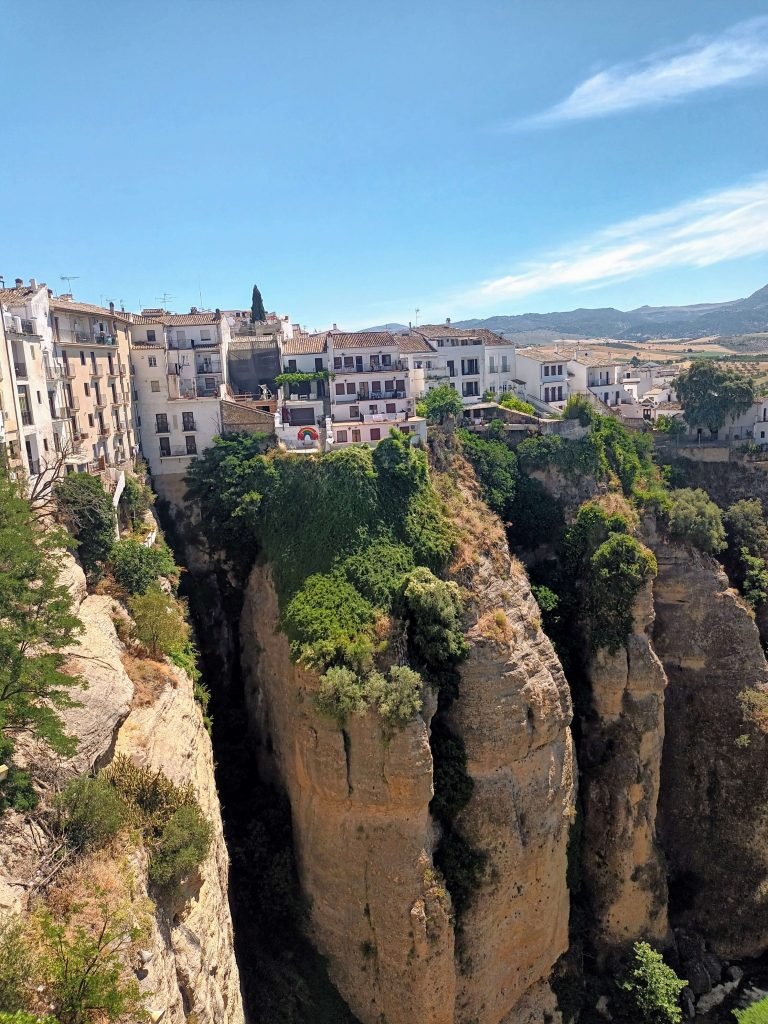

I was lucky enough to visit Ronda recently, and as I meandered through the Old Town and gawped at the endless stunning vistas, I had to keep reminding myself that I was in Spain, not Tuscany!
Although I only had one day in Ronda, it was definitely enough to get a feel for the city, and so I thought I’d put together this quick guide to the top things to do in Ronda, Spain, in just a day.
At the end of this guide you’ll find some practical information, including how to get to Ronda, where to stay in Ronda, when to visit Ronda, and much more.
So, is Ronda worth visiting?
Let’s take a look at what to see in Ronda, Spain, in one day and then you can tell me if I’ve persuaded you that it is!
The 10 Top Things to Do in Ronda, Spain
Ronda in a Nutshell
Dating back to Neolithic times (approximately 10,000BC!), Ronda is one of the oldest cities in Spain, and with a population of just 34,000, it still has that sleepy small town feel to it.
Although its world-famous views have placed Ronda firmly on the tourist map of Andalusia, Ronda still feels very much like a working Spanish town (as opposed to Nerja, which, while stunning, definitely feels like a tourist town), and if you walk just a couple of kilometres in any direction, you’ll find yourself surrounded by nature.
Not only is Ronda famous for its landscape, but it is also the birthplace of modern Spanish bullfighting.
It was in Ronda that Francisco Romero faced the bull on foot for the first time in the 18th century, rather than on horseback.
His son, Pedro, became one of Spain’s greatest bullfighters and founded the Ronda School for Bullfighting, which is still known for its strict adherence to the standards that Pedro held himself to.
Sidenote: I am not supportive of bullfighting by any means, but it is essential when visiting Ronda to understand that this city is steeped in the tradition of bullfighting, and it is impossible to understand Ronda without understanding this.
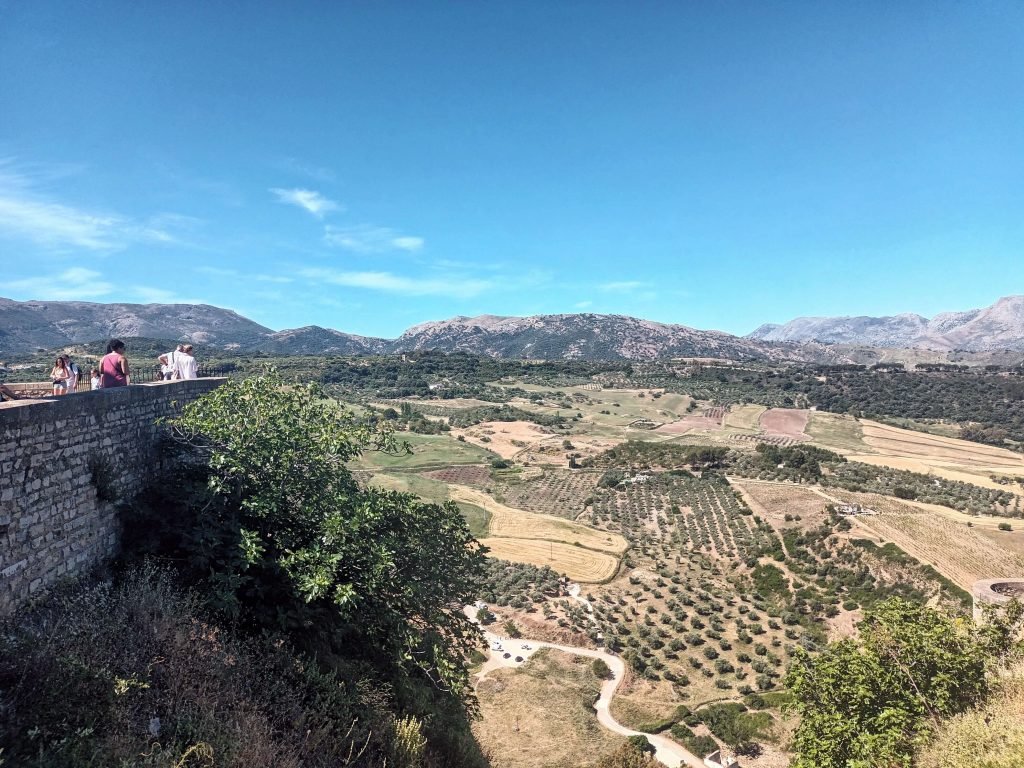
The countryside around Ronda is famous for winemaking, and Ronda is one of the most recent additions to the official wine routes that can be found across Spain.
A Ronda day trip then, combines nature with stunning architecture, thousands of years of history, and, of course, wine.
A Day Trip to Ronda
I always advise my readers to spend at least a night or two in a given destination.
This allows you to see the quieter side of town, after the tour buses have left, as well as getting a deeper understanding of the place you’re visiting.
However, sometimes all we have is one day, and if you’re considering a day trip to Ronda, I recommend taking a guided tour like I did.
Guided tours are a great way to ensure that you see as much as possible while learning the cultural and historical contexts of everything you’re seeing.
Below are my picks from GetYourGuide for the best Ronda day tours. Please note that I haven’t personally been on these specific tours, so do read the reviews and itineraries carefully to be sure that they’re what you’re looking for!
2.5 hour Ronda Sightseeing Tour
From Malaga: Ronda Day Trip
From Seville: Ronda Day Trip
Private Winery Tour and Ronda Visit
Best Things to Do in Ronda, Spain
1. The New Bridge
Completed in 1793 after 42 years of construction, the so-called ‘New Bridge’ (or Puente Nuevo in Spanish) is actually not so new at all, but compared to the other bridges in this city, it kind of is.
The New Bridge is without doubt the main tourist attraction in Ronda, and it is impossible to visit Ronda and not spend some time admiring this impressive structure and the deep gorge that lies beneath.
The first attempt to complete this bridge in 1741 resulted in tragedy when the entire thing collapsed, killing 50 people.


A great spot to get a view of The New Bridge is from the Parador de Ronda hotel, where you can also buy a ticket to visit the tiny 19th century prison inside the bridge (2.50 EUR).
Another Ronda bridge viewpoint is Mirador de Aldehuela, which is the most popular spot from which to see the New Bridge, as well as the Balcón del Coño, which literally translates to something rather rude, but Spaniards use ‘coño‘ to mean something like ‘sh-t!’
If you want to admire Ronda’s New Bridge from below, it is possible to actually walk down into the gorge and see it.
There are a few ways to do this – you can take the 200 stone steps from the Casa del Ray Moro, follow the trail that begins at the Puerta de Almocabar or take a hiking route.
2. Cuenca Gardens
The Jardines de Cuenca, which take their name from Ronda’s sister city of Cuenca, are located on the edges of the Tajo gorge and also offer phenomenal views of the New Bridge and the Guadalevin River beneath.
However, as well as being a great Ronda bridge viewpoint, you can also see the Casa del Ray Moro and the Convent of Santa Domingo from here, and with a series of terraces and rose gardens, the Cuenca Gardens are well worth a visit in themselves!
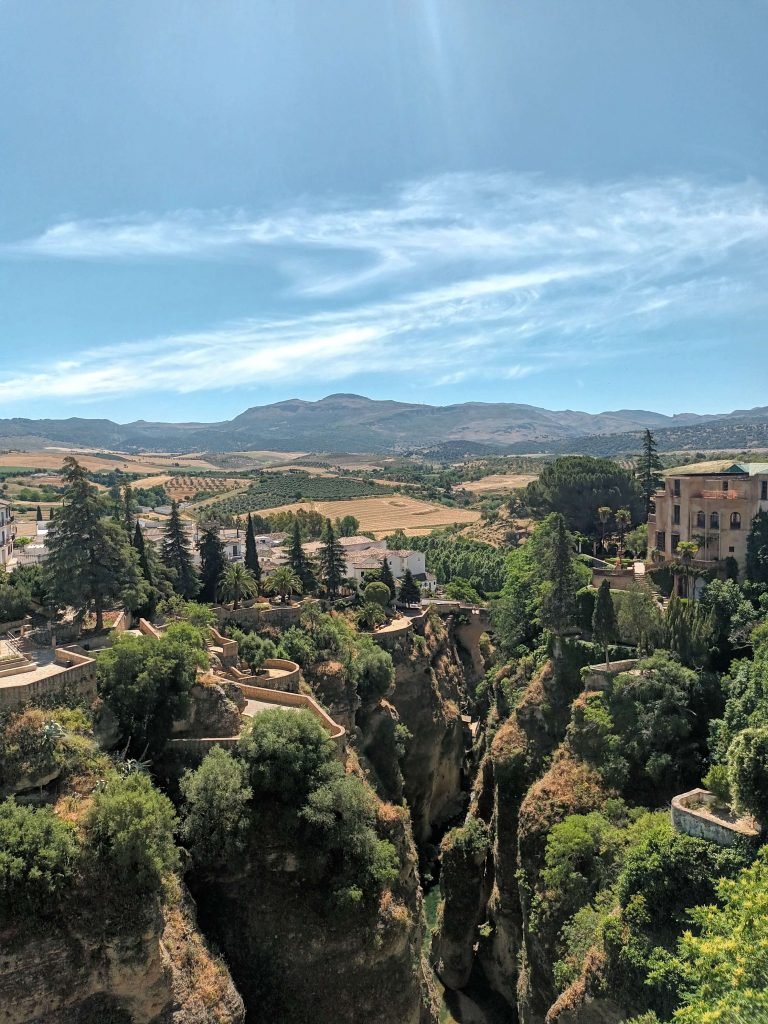
3. Plaza de Toros de Ronda – Ronda’s Bullring
As I mentioned earlier, Ronda is the birthplace of modern Spanish bullfighting, and dating from 1785, the Plaza de Toros de Ronda is Spain’s oldest bullring.
In terms of architecture, this neo-classical building is quite the sight to behold (it was actually built by the same architect that built the New Bridge), and it holds a whopping 5000 people.
Outside is a statue of Antonio Ordonez, a prominent Ronda bullfighter, as well as a life-size statue of a bull.

These days, there is only one bullfight per year, but one of the most popular things to do in Ronda Spain is to take a tour of the bullring and museum inside.
The entrance fee for the museum is 8 EUR, and you can purchase an audio guide for an additional 1.50 EUR.
4. Alameda de Tajo
Ronda’s 19th century Alameda de Tajo park is a lovely spot to enjoy a bit of shade and watch the world go by.
With numerous fountains, a duck pond, bird enclosure and children’s play area, Alameda Park is very popular with local residents, who enjoy taking their evening stroll here.
At the front entrance to the park near Virgen de la Paz, you will find a statue of Pedro Romero, Spain’s best bullfighter, who fought from age 8 to age 70 and was said to have killed 6000 bulls during his bloody career.


There is also a statue of a Lady Goyesca, dedicated to the Goyesca Ladies who have had the opportunity to be chosen as the leading Goyesca Ladies and presidents of the annual Ronda fair over the years
There are numerous viewpoints located here where you can enjoy panoramic views of Ronda’s olive groves, almond trees and rolling hills.
5. Discover Ronda’s Other Bridges
Ronda’s New Bridge may be the most iconic, but you can’t miss the Old Bridge (Puente Viejo), which dates back to 1616, and the Puento Romano, which goes back to Ronda’s Moorish period between the 9th and 15th centuries.
You can actually walk across the Old Bridge, which is the smallest of the three, and enter the city walls through it.
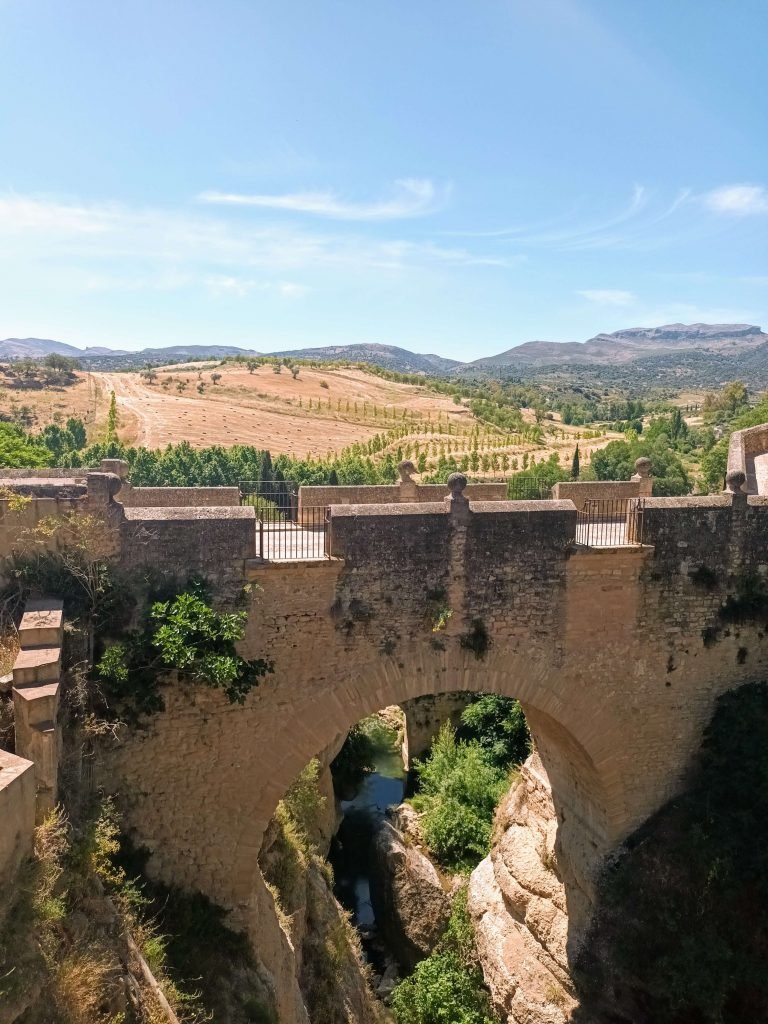
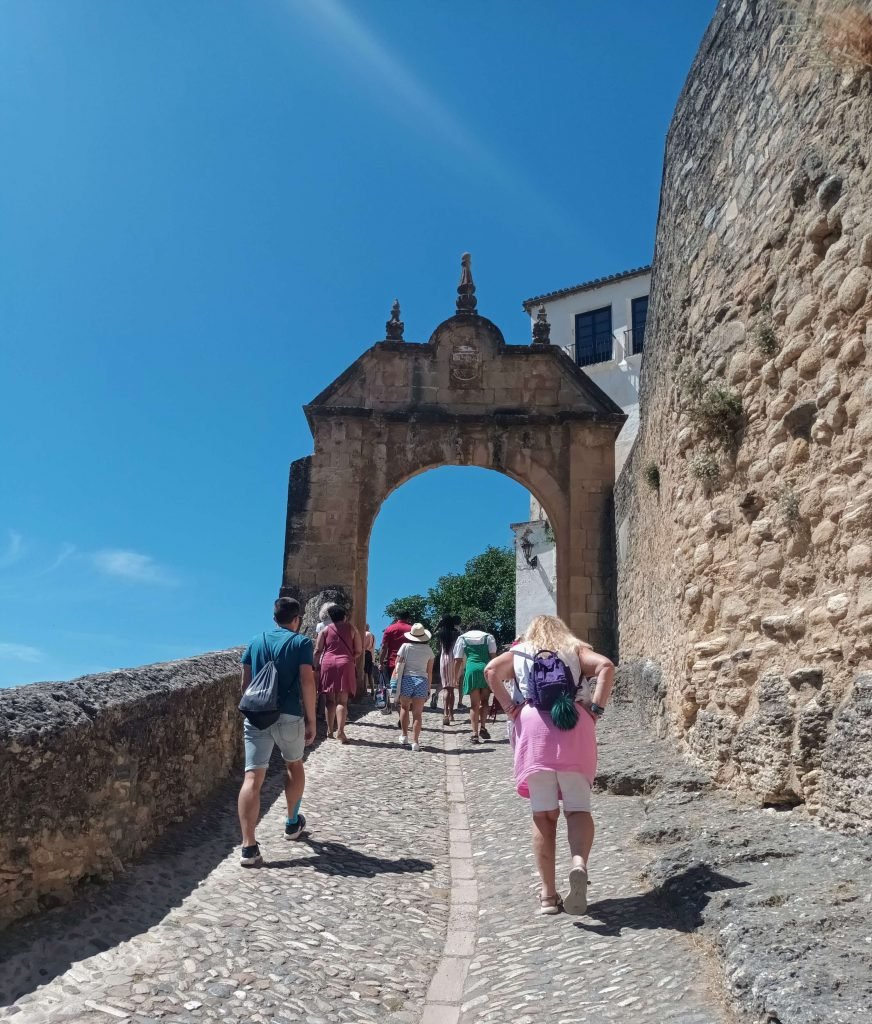


6. Arab Baths
Unfortunately, I didn’t visit the Arab Baths in Ronda (though I visited the ones in Jaen a few days later!), but they are without a doubt one of the best things to do in Ronda, especially if you’re a history lover.
Ronda’s Arab Baths, (Baños Arabes) date back to the end of the 14th century and are some of the most well-preserved Arab Baths in the whole of Spain.
Just like the baths in Jaen, Ronda’s Arab Baths have star-shaped ventilation holes in the roof, which were modelled after the bathhouse in the Alhambra in Granada.
Entrance to Ronda Arab Baths is 4.50 per person.
7. Ronda Old Town
Ronda is divided into two parts – the Old Town (La Ciudad) and the New Town (El Mercadillo).
While the 18th century El Mercadillo is a pretty regular Spanish town, the Old Town dates back to 45BC and is a quaint place to enjoy a stroll.
Whitewashed buildings, cobbled streets and Moorish influences make Ronda’s Old Town just charming, and despite Ronda being fairly touristy, the Old Town was super quiet when I visited – I guess everybody was too busy admiring the bridges!

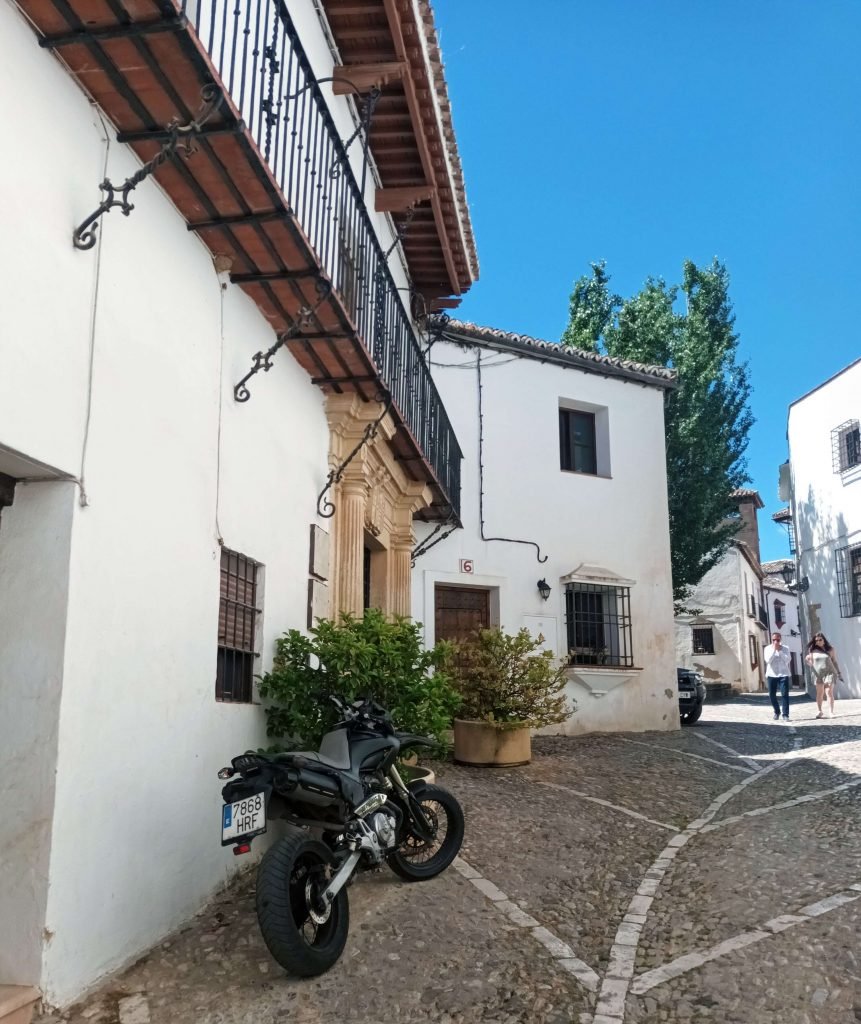
8. The Carmelite Convent (or The Secret Bakery)
Not only is the Iglesia de Nuestra Senora de la Merced (Church of Our Lady of Mercy) a sight to behold with its Mudejar architecture, but its adjoining Carmelite Convent is home to 25 nuns that never leave the premises and devote their lives to ‘prayer, penance and perpetual abstinence.’
However, when they’re not praying, the nuns also bake fresh cookies, bread and cakes, which they sell every morning and late afternoon from a small room to the left side of the church.
You can go and buy some snacks from the nuns, but you won’t actually get to see them – everything is done via a rotating Lazy Susan, on which the nun will place your order.
Once your order appears, you place the money on the Lazy Susan and send it back around to the nun, never even catching a glimpse of her!

9. Duchess of Parcent Square
The Duchess of Parcent Square (Plaza Duquesa de Parcent in Spanish) is a gorgeous square where you can grab a coffee in one of the many cafes and enjoy the sun.
This is where everything happens in Ronda, and you can really get a feel for local life here.
Of course, being in Europe, there’s a magnificent church here, the Church of Santa Marîa la Mayor.
This church took almost 200 years to build and is a mixture of Renaissance and Gothic style, as well as some Baroque elements.
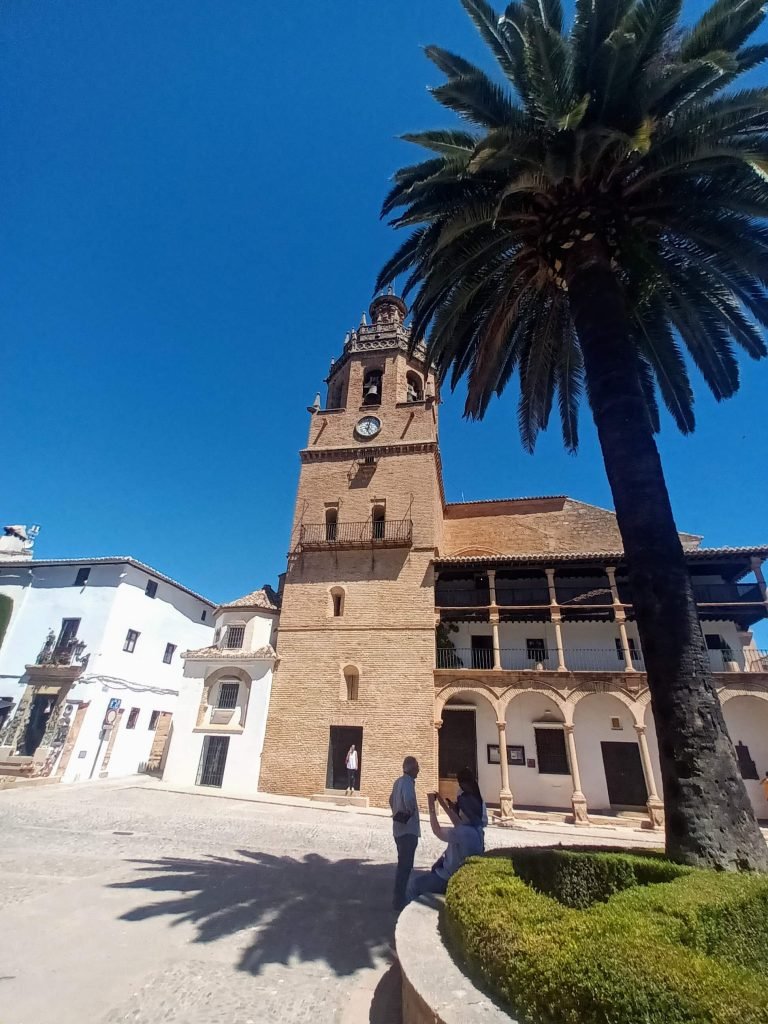
10. Visit one of Ronda’s Wineries!
Readers of this blog will know that I love visiting a good winery, and so when I heard that my group would be visiting one of the 25 wineries dotted around Ronda, I was buzzing.
Bodega Joaquin Fernandez is an organic family winery that dates back to the year 2000.
The more extreme climate (the winery is 700m above sea level) results in the grapes having an intense flavour, and although Bodega Joaquin Fernandez is a relatively small operation, it still manages to produce 50,000 bottles of wine every year!
My group and I enjoyed a tour of the winery and a tasting of four different wines, which we enjoyed with platters of cold meat and cheese, and fresh salad.
Especially interesting was the ‘white’ wine which is actually made from red grapes, and although the skin is immediately separated from the grapes, the wine remains a slight pink colour as a result.
However, despite what it may look like, this wine is not a rosé wine, but indeed a white, and its name is Blanco de Uva Tinta, which translates to ‘Red Grape White!’
When we’d tried all four, we were served generous portions of arroz de campo, a simple rice dish from the Spanish countryside with chicken, peppers and green beans.
I have no idea what the other 24 Ronda wineries are like, but I can certainly recommend Bodega Joaquin Fernandez!




Getting to Ronda
By now I’m sure you’re itching to visit Ronda and see all of these beautiful views for yourself, and luckily, Ronda is pretty easy to get to.
The closest airport to Ronda is Malaga.
If you are renting a car, you can get from Malaga to Ronda in 1h30, or from Sevilla to Ronda in 1h45.
The best places to find a rental car are QEEQ and Rentalcars.
If you prefer public transport, there is a direct 2h train from Malaga to Ronda (once per day), and other trains where you need to change train at Antequera-Santa Ana.
There up to four buses from Malaga to Ronda every day and the bus journey takes about three hours.
Check trains and buses on Omio.
When is the Best Time to Visit Ronda?
The best time to visit Ronda is undoubtedly the shoulder season.
Not only are the summer months going to be super crowded, but Ronda also gets unbearably hot, despite its high altitude.
March-May and September-October will still almost guarantee great weather but without the crowds.


Where to Stay in Ronda?
Whether you want a fancy hotel or a quaint guesthouse, Ronda is not short of great options.
I’ve selected my top three picks for Ronda accommodation, based on budget.
Parador de Ronda – $$$
The Paradores of Spain are state-owned buildings of note that have been renovated and turned into swanky hotels.
The Ronda Parador hotel is in the former town hall and boasts magnificent views of Ronda’s New Bridge and the El Tajo gorge.
This impressive 4-Star hotel offers concierge services, an outdoor swimming pool, spacious gardens and two gourmet restaurants (the Paradores are known for having world class restaurants).
Los Pilares de Ronda Boutique & Hotel-Antigua Finca – $$
Los Pilares is a perfect escape from the world. Located just under 3 miles from the centre of Ronda, this property has its very own horse ranch, riding school, two swimming pools, a spacious picnic area and a range of gardens and terraces to enjoy.
If you’re looking for somewhere that you can retire to at the end of the day and enjoy true peace and quiet, this is it.
Casa Ronda 1808
Casa Ronda 1808 is a quirky homestay with weird and wacky interior and large roof terrace perfect for catching those rays.
It’s based in the centre of town and at less than 50 EUR per night (at the time of writing), it’s a real bargain, if you don’t mind the rather eclectic décor.

Is Ronda Worth Visiting? | Final Thoughts
So, is Ronda worth visiting?
Yes, yes and again for the people at the back – YES!
Whether you want sweeping views reminiscent of Tuscany, excellent wine, traditional mountain food or thousands of years of ancient history, Ronda will not disappoint.
Unfortunately I only had one day in Ronda but I would love to go back sometime with my partner and stay for a few nights, discovering the local restaurants and washing down all of that Andalusian food with some delicious local wine.
More Andalucia Guides
If you’re planning a visit to Andalucia, you may find my other Andalucia destination guides helpful!
17 Travel Tips for Malaga
24 Traditional Malaga Dishes You Have to Try
A Guide to Jaen
Guide to Ubeda and Baeza, the Renaissance Cities of Andalucia
10 Reasons to Visit Marbella
The Best Things to Do in Nerja
The Best Things to Do in Cordoba
That’s all I’ve got for this article, but as always, if you have any questions then don’t hesitate to reach out in the comments section below!
Until next time,
XOXO
If you liked this article and would like to support my work, please click the button above to donate a couple of bucks and buy me a coffee. The ad revenue that I receive on this website is minimal, so support from my readers enables me to keep creating content that you (hopefully!) love to read.
Disclaimer: This page contains affiliate links. If you make a purchase on a recommended site, I may earn a commission at no extra cost to you.


I love this report! Your expertise shines through your sassy style! Thanks for the recos!
Thanks so much Stacey!!
Great article! I’d love to visit Rhonda!
Also wanted to say thank you for the very helpful blogging resources received after signing up to your mailing list!
Thanks so so much!!